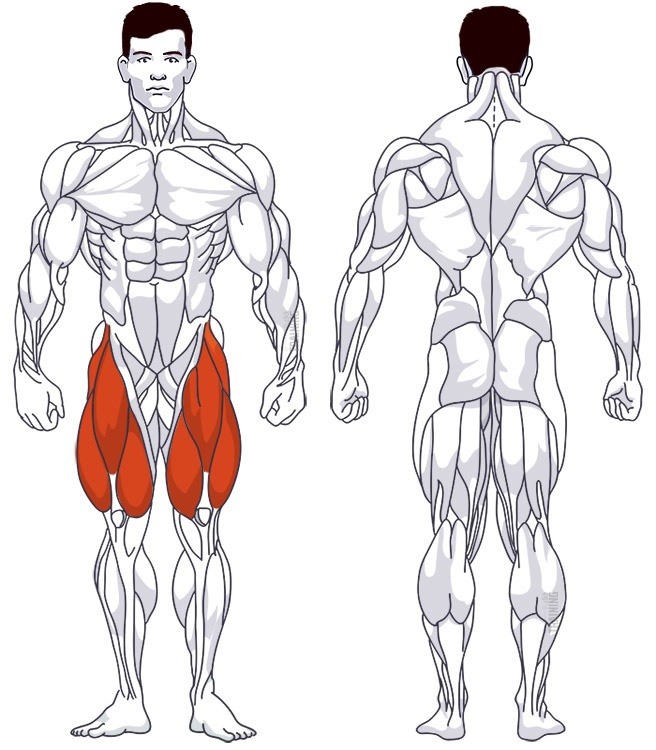Leg Extensions
Isolation exercise, MachineThis article is verified by 3 studies/publications.
Overview

Main muscles
- Thigh: Quadriceps
(Musculus quadriceps femoris)
Leg Extensions: Basics and alternatives

Involved main muscle groups:
Leg Extensions
During leg extensions, you sit upright on the machine and work out the front part of your thighs (quadriceps). As the name implies, while seated, you extend your legs, which are tucked under a leg pad, to move the weight.
Leg extensions on the machine can be considered a counterpart to lying leg curls on the machine. It’s a fantastic exercise to train the front thigh muscles in isolation. However, some critics see a potential danger to the knee joints with this exercise.
Dangerous or harmless?
Throughout the exercise, a lot of stress is placed on the cruciate ligament and the kneecaps. This stress increases with increasing weight, which – at least not in this form – isn’t the case with squats[1].
Although the stress on the cruciate ligament and kneecaps can’t be denied, some still see no problem in including leg extensions in their workout routine. Some argue that the load limits of the cruciate ligament are significantly higher than the forces that occur during normal exercise execution (about 12 repetitions).[2].
In short, there’s currently no consensus on the subject. In any case, to perform leg extensions as safely as possible, keep in mind that this isn’t a maximum strength exercise. Choose a lighter weight (for 12-20 repetitions) and perform the exercise (as always) with control and without swinging. In addition, set up the machine correctly (explained below). Also, make sure to do a balanced thigh workout that includes working your hamstrings.
If you already have knee or cruciate ligament issues, discuss the exercise with a doctor just to be safe.
Correct execution
Even though leg extensions can be done relatively easily, it’s important to ensure that the machine is set up correctly so you don’t put unnecessary stress on your knee joints (see above).
Most leg extension machines have two important adjustment options. First, you can adjust the position of the backrest, and second, the position of the shin pad.
Adjust the backrest so that your knee joints align with the pivot of the machine. If this isn’t possible because the machine’s setup is different from the picture above or the video below, talk to a gym employee and ask for the correct setup. This is important to avoid increasing the leverage unnecessarily.
Additionally, the leg-lock shouldn’t be too low. Usually, the optimal height is at the lower shin – just above the foot. To minimize the stress on the cruciate ligament, you can place the pad even further up – towards the middle part of the shin.[3].
Video tutorial
Step-by-step instructions
Sit down on the seat.
Adjust the backrest/seat and leg pad to fit your size (see above).
Choose a weight that you can move 12 to 20 times.
Press your butt into the seat by firmly grabbing the handles on the sides with your hands.
Now, move your lower legs upwards by extending your knees. Perform the movement smoothly and without swinging.
Lower your legs again at the end of the movement – also evenly and without swinging.
Common mistakes
Make sure the machine is adjusted to fit your body. This is particularly important to prevent increasing the leverage and forces on the cruciate ligaments unnecessarily.
Stay conservative with your weight choices. In other words, don’t use heavy weights, but do leg extensions in a higher repetition range.
Always perform the exercise without swinging. The training stimulus would be reduced, and the stress on the knee joint increases significantly due to swinging movements that have to be slowed down/stopped. Therefore, perform the leg extensions – like all your exercises – in a controlled manner throughout the entire range of motion.
Don’t fully extend your knees at the end of the movement; keep them slightly bent.
Sources
- The strain behavior of the anterior cruciate ligament during squatting and active flexion-extension. A comparison of an open and a closed kinetic chain exercise. Beynnon BD1, Johnson RJ, Fleming BC, Stankewich CJ, Renström PA, Nichols CE. Am J Sports Med. 1997 Nov-Dec;25(6):823-9. doi: 10.1177/036354659702500616. URL: https://www.ncbi.nlm.nih.gov/pubmed/9397272, accessed 12/04/2020.
- Are the Seated Leg Extension, Leg Curl, and Adduction Machine Exercises Non-Functional or Risky? Andrew Vigotsky, NSCA-CPT and Nick Tumminello NSCA-CPT. Personal Training Quarterly June 2017 Vol 4, Issue 4. URL: https://www.nsca.com/education/articles/ptq/are-the-seated-leg-extension-leg-curl-and-adduction-machine-exercises-non-functional-or-risky/, retrieved 12/04/2020.
- Dependence of cruciate-ligament loading on muscle forces and external load. Pandy MG, Shelburne KB. J Biomech. 1997 Oct;30(10):1015-24. doi: 10.1016/s0021-9290(97)00070-5. URL: https://www.ncbi.nlm.nih.gov/pubmed/9391868, accessed 12/04/2020.